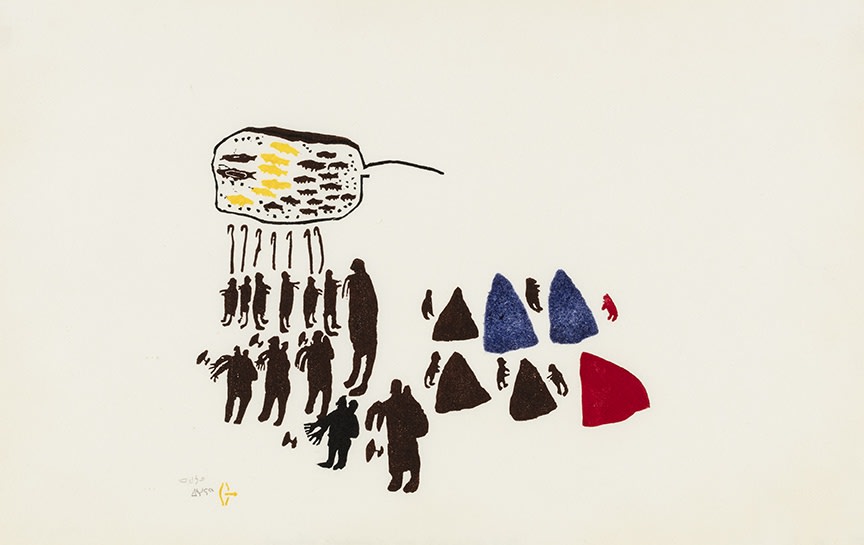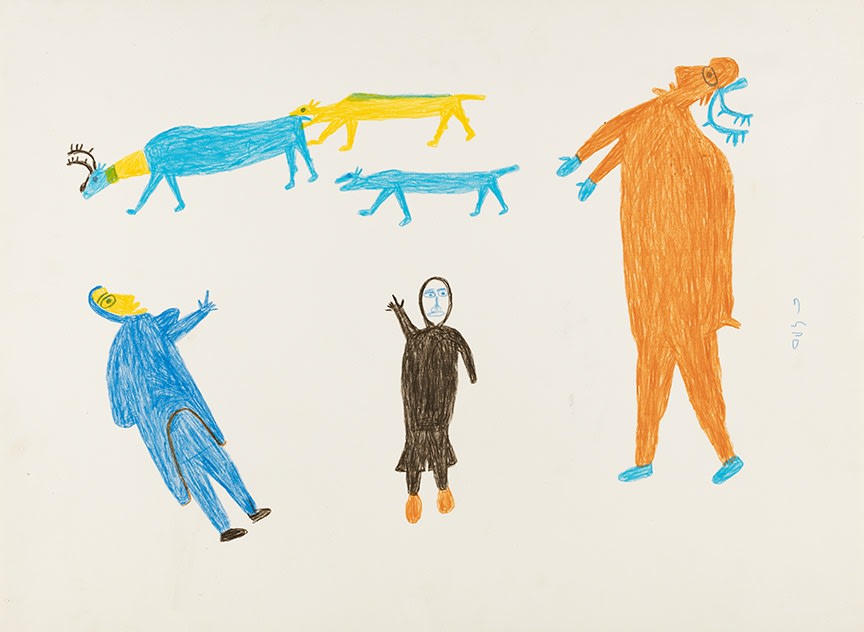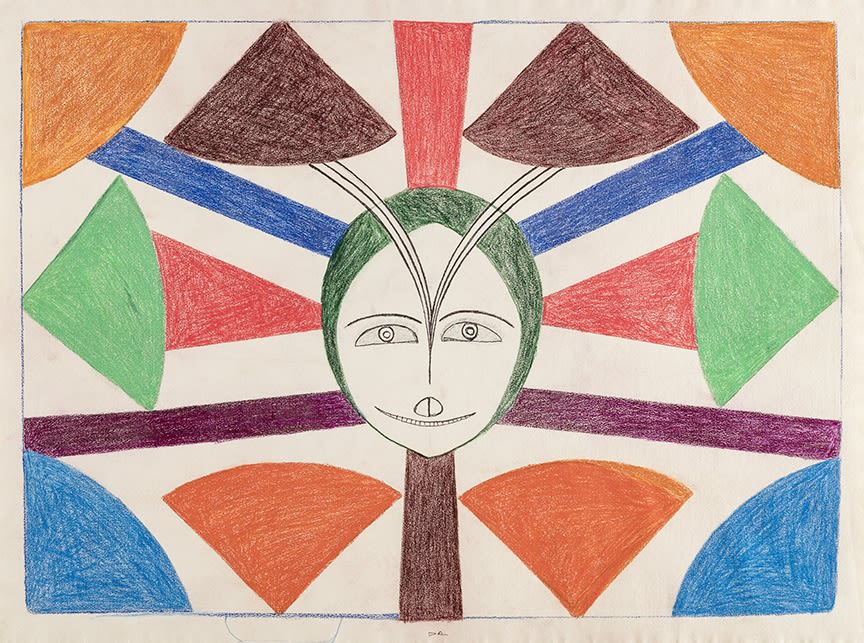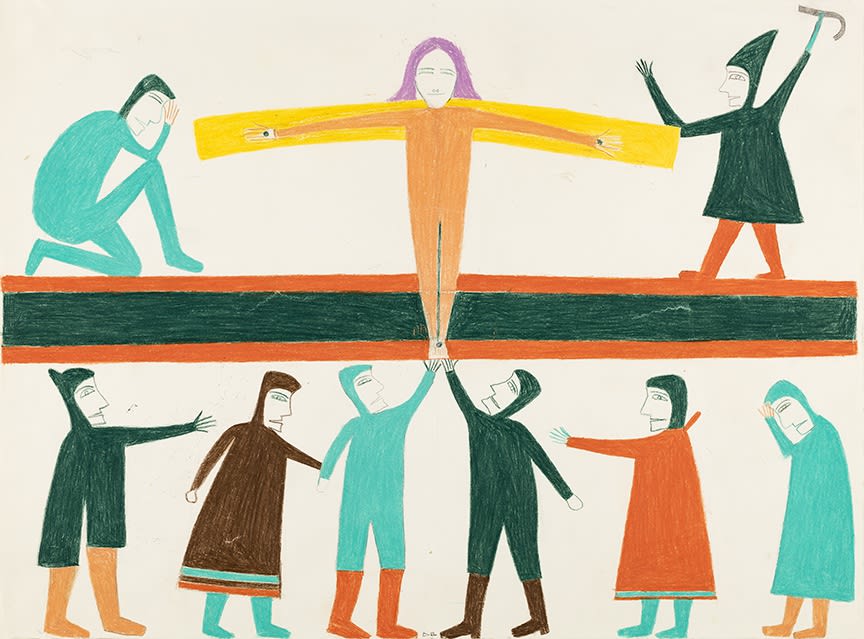By the time the first Baker Lake print collection was released to the public in the spring of 1970, Inuit prints had become an established and vital part of the Inuit art market. The first “official” Kinngait (Cape Dorset) print collection had occurred ten years earlier; Puvirnituq printmaking was almost a decade old; and Holman printmaking a half-decade. Although Jessie Oonark had begun drawing in 1958 or 1959 and even had three drawings translated into Cape Dorset prints in 1960-61, Baker Lake graphics experiments advanced only in fits and starts until the late 1960s, and only really took off after the arrival of Jack and Sheila Butler in 1969. After what must have been a frantically paced and exciting few months of artistic activity, the 1970 Baker Lake collection exploded onto the scene.
Qamani’tuaq (Baker Lake) became known for stonecut and stencil prints (often in combination), generally displaying the vibrant and seemingly “unconventional” colour sense of the artists’ original drawings. The first exhibition of Baker Lake drawings was held at the Winnipeg Art Gallery in 1972, and drawings were soon also regularly shown in commercial galleries, notably the Innuit Gallery of Eskimo Art in Toronto and the Upstairs Gallery in Winnipeg. At the same time, Qamani’tuaq gained fame for its works on cloth and sculptures. It was a remarkable flowering of artistry, rivalling the similar outpouring of creativity in Cape Dorset in the late 1950s and early 1960s.
The small community of Qamani’tuaq ended up producing an incredible number of talented artists in various media. The two artists whose drawings and prints have garnered the most attention are Luke Anguhadluq and Jessie Oonark. The two cousins had actually been promised to each other as marriage partners when they were young children, but that did not come to pass. Oonark and Anguhadluq do, however, share a legacy as two towering figures in the history of Inuit graphic art.
Anguhadluq was born near Chantrey Inlet on the southern coast of the Arctic Ocean but spent much of his life in the Back River area, where he became a respected camp leader. Twice widowed, he married Marion Tuu’luq (see Lot 21) around 1955, and the couple moved to Baker Lake around 1961. He created his first graphite and felt pen drawings between 1966 (at age 71) and 1969 during Boris Kotelewetz’s time as crafts officer in Baker Lake but took up artmaking seriously with the encouragement of the Butlers later in 1969. Anguhadluq’s drawings quickly “expanded” – in scale, in complexity, and in their use of vibrant colour.
Fishing Camp (Lot 76) is a delightful, yet quite compelling image based on one of the artist’s earliest drawings (c. 1967). Anguhadluq’s early depictions of human figures are charmingly naïve; we love the way he has attempted to show the almost zombie-like figures’ arms in various configurations! The artist’s favoured iconography and his use of multiple perspectives is already apparent. Interestingly, Hooks and Spears, a 1976 print based on a 1974 drawing, echoes the row of fishing gaffs pictured in Fishing Camp, but here Anguhadluq has created a remarkable semi-abstract image imbued with symbolism. The 1978 coloured pencil drawing Caribou, Wolves, Figures, and Shaman, with its vibrant colours and sense of narrative, is a fine example of Anguhadluq’s later mature style and a rare example of shamanic imagery in the artist’s work.

Lot 76
LUKE ANGUHADLUQ (1895-1982), QAMANI’TUAQ (BAKER LAKE)
Fishing Camp, 1970 (1971 #28), stonecut and stencil print.
ESTIMATE:: $1,500 — $2,500
In Fishing Camp, Luke Anguhadluq recreates a favourite summer activity from his former life in the Back River area, capturing the communal spirit and gender roles inherent in the traditional Utkuhikhalingmiut way of fishing. Men stand poised with nigshiit, gaffs they will use to rake the shoals of yellow and black fish in the haputit (weir) at the top. Awaiting their cue, they look towards the camp leader, whom Anguhadluq portrays as noticeably larger, emphasizing his central role. Women with children in their amautiit stand by with their ulus ready to clean the impending catch. To the right, figures assemble skin tents that are spontaneously inked in bright red and blue, which adds a captivating extra burst of colour to the image. The entire scene radiates with the palpable excitement that would have coursed through the participants of these communal fishing endeavors.

Lot 28
LUKE ANGUHADLUQ (1895-1982), QAMANI’TUAQ (BAKER LAKE),
Hooks and Spears, 1976 #10, stencil print.
ESTIMATE: $3,500 — $5,000
A minimalistic ode to an old hunter’s life on the land, Hooks and Spears captivates us with its dazzling, abstract simplicity. Two rows of fishing implements appear at rhythmic intervals across the page, divided by a horizontal green stroke that may represent a waterline or groundline. These tools symbolize the enduring connection between Anguhadluq and his community to the migratory fish in the Back River area, which they harvested in weirs during the bountiful warm seasons. In the top register, inked in orange, are the kakivak trident spears poised for the pierce. Below is a row of nigshik hooks or gaffs, used to sweep up teeming schools of fish that might appear in the weirs. The nigshik was often the preferred fishing tool among the Utkuhikhalingmiut. To Anguhadluq, the symbolism of these implements must have been at least as powerful as that of the ulu.

Lot 63
LUKE ANGUHADLUQ (1895-1982), QAMANI’TUAQ (BAKER LAKE)
Caribou, Wolves, Figures, and Shaman, 1978, coloured pencil drawing.
ESTIMATE: $3,000 — $5,000Distinguished by Anguhadluq’s distinctive later drawing style with the generous swirls of vibrant colours in pencil crayon that the artist employed to realize his vision, this work presents an enigmatic scene that includes a hybrid caribou-shaman. Jean Blodgett noted that Anguhadluq sometimes portrayed hunters carrying parts of their catches, like caribou heads, in a way that makes them appear as if they have grown antlers, but she also acknowledges that other images clearly depict transformations. This classic image surely presents the latter. It may be that the shaman is attempting to save the family’s potential catch from the predations of two wolves.
In contrast to Anguhadluq, Jessie Oonark had been creating art of one kind or another all through the 1960s. Widowed and trying to survive on the land with her two youngest children, she had been flown to Baker Lake in 1958. First Arts had the privilege to offer what is probably her earliest drawing (late 1958 or early 1959) in our December 2020 sale (Lot 52). As mentioned above, Oonark’s early drawings drew some attention, and she did create some remarkable graphite drawings in the early 1960s, but she mostly sewed clothing and lovely, charming works on cloth in the early to mid 1960s. With the encouragement of Boris Kotelewetz she began drawing steadily from about 1966. A magnificent and monumental drawing from this period is illustrated in the WAG’s 1986 catalogue Jessie Oonark: A Retrospective (cat. 16, p. 1977) and is now in the collection of the National Gallery of Canada. In Oonark’s case, the Butler’s had the advantage of dealing with a seasoned artist.
Boris Kotelewetz had given Oonark her own small, dedicated space at the craft shop to use as a studio, and this is probably where she drew the lovely and lively Muskox c. 1967. This brilliant drawing is very much in the spirit of those published in Sarah Milroy’s fascinating IAQ article “Flashback: Jessie Oonark” (Fall 2017:82-95). The compelling little print Voice from my Dreams from 1973 illustrates how Oonark was beginning to move back and forth between the two media of drawing and sewing, and clearly illustrates her growing interest in symmetrical composition and symbolism. The flowering of her mature style is fully evident in the spectacular drawing Face with Ulus, c. 1974. This gorgeous drawing is a bold and confident image, charged with symbolism and imbued with Oonark’s pride in her womanhood and independence. Another highly important drawing by the artist is Giver of Life from c. 1978, which was translated into the famous print of that name for the 1983/84 Baker Lake collection. It’s a remarkable image that illustrates how Oonark’s interest in the supernatural is revealed not only in her shamanic imagery but also in her Christian subject matter.

Lot 64
JESSIE OONARK, O.C., R.C.A (1906-1985), QAMANI'TUAQ (BAKER LAKE)
Muskox, c. 1967, pencil crayon over ballpoint pen, and felt tip pen? drawing.
ESTIMATE: $4,000 — $6,000Exhibited and Published: Jessie Oonark: A Retrospective, Winnipeg Art Gallery, Nov. 1986 - Feb. 1987 (Canadian tour 1987-1988); catalogue: Jean Blodgett and Marie Bouchard, (WAG, 1986), no. 32, p. 108, as “Untitled, c. 1969”.
In this remarkable rendering of a charging muskox, Oonark captures the lively spirit that is characteristic of her graphic work from this period. With gestural strokes in ink and pencil crayon, she both defines and animates the creature, imbuing the animal with extraordinary energy. Presented in isolation and stripped of any extraneous context, the muskox becomes a focal point of pure expression. Its splayed limbs and hybrid aerial-frontal perspective lend it an endearing, naïve (dare we say goofy?) charm, making the image not just a representation of the muskox, but a celebration of the animal's innate vitality. Fabulous.

Lot 26
JESSIE OONARK, O.C., R.C.A (1906-1985), QAMANI'TUAQ (BAKER LAKE)
Voice from my Dreams, 1973 #17, stonecut and stencil print.
ESTIMATE: $4,000 — $6,000
Voice from my Dreams beautifully showcases Jessie Oonark’s signature elements of symmetry and iconic feminine imagery in a simple yet powerful composition. At the centre an ulu shape radiates from a woman’s tattooed face; her torso doubles as a tattooed bird face. Oonark often dismissed questions about the meaning of her works with offhand comments such as “it doesn’t mean anything, it just came from my mind.” We are constantly reminded just how sophisticated and brilliantly inventive Oonark’s mind was. This almost spectral scene in yellow with accented red unfolds against a dense black. The near-symmetry of the left and right, and the way in which the various figures connect to each other, remind us of similarly composed, contemporaneous prints by Oonark, for example Figure in Striped Clothing from 1972 and High Play, also from 1973 – both of which were based on small works on cloth. We would not be at all surprised if Voice from my Dreams was found to be similarly inspired by a small appliqué and embroidery hanging.

Lot 104
JESSIE OONARK, O.C., R.C.A (1906-1985), QAMANI'TUAQ (BAKER LAKE)
Face with Ulus, c. 1974, coloured pencil and graphite drawing.
ESTIMATE: $10,000 — $15,000Jessie Oonark’s Face with Ulus is a bold explosion of colours and forms. Beautifully mirrored along its vertical axis (and almost along the horizontal one), the image focuses our attention on the lovely central face of a young woman. Ulu shapes anchor the composition at the four corners, and more dance among the coloured bars radiating from her. These bold geometric forms contrast with the woman’s ever so delicate facial features. These include traditional forehead tattoo lines that extend beyond her face like antennae or slender antlers to connect with the nearest ulu blades.
Face with Ulus was created in the same period as Oonark’s masterpiece Big Woman (see First Arts, 12 June 2023, Lot 37). We sense that Oonark’s thoughts and hand were heading in the same direction here, with a similar strong use of colour and a desire to highlight the feminine as artistic inspiration, though with more focused symbolism and greater simplification and repetition of abstract form. The image literally “radiates” both sensitivity and strength and possesses a truly striking emblematic quality that invites comparison with Kenojuak’s The Enchanted Owl (see Lot 11). To our minds it would have been a perfect flag design for the Territory of Nunavut.

Lot 23
JESSIE OONARK, O.C., R.C.A (1906-1985) QAMANI'TUAQ (BAKER LAKE)
Giver of Life, c. 1978, coloured pencil drawing.
ESTIMATE: $8,000 — $12,000Exhibited and Published: Jessie Oonark: A Retrospective, Winnipeg Art Gallery, Nov. 1986 - Feb. 1987, (Canadian tour 1987-1988); catalogue: Jean Blodgett and Marie Bouchard, (WAG, 1986), cat. 79, p. 134.
Baptized as an Anglican in 1944 as "Jessie Onak,” by the mid-1960s Oonark had begun to incorporate Christian themes in her art. She often blended traditional shamanic and Christian imagery in her drawings and works on cloth but occasionally, as in this important drawing from 1978, Oonark focused solely on a Christian theme. Illustrating the intensity of her devotion, Oonark presents one of the most enduring themes in Christian art: the crucifixion of Jesus. The figure of Christ is frontally facing, his limbs elongated, and his body limned in a warm yellow orange, as if glowing with brilliant spiritual presence. In the top left and lower right, two figures cast their gazes downward, their hands raised in anguish and sorrow. Elements of other aspects of the Passion of Christ are present in the work. In the top right, a tormentor readies what may be a whip but might be a hammer. In the lower centre two men – likely soldiers – raise their arms upwards as they elevate the crucifix. They are flanked by two figures whose arms are held forth in a seeming bid to arrest the action.
Oonark depicts the wooden cross in a way that alters our perception of the event. What is presumably the heavy upright post of the cross is here shown horizontally, dividing the image into two tiers – which happens to neatly conform to the artist’s favoured compositional style. Since the post and the crosspiece are shown separately, we wonder if the cross is being either constructed or dismantled. If it is the latter that Oonark is illustrating, this image of Christ as a floating or even soaring bird-like figure – accentuating the ethereal and supernatural rather than the physical - probably represents his Ascension, which explains the title Giver of Life. Remarkable.
This drawing was translated into a famous stencil print by Magdalene Ukpatiku for the 1983/84 Baker Lake collection (#16). Because Oonark was too ill to travel, a copy of the print was presented by Janet Kigusiuq, Oonark’s eldest daughter, to His Holiness Pope John Paul II during a public mass held in Ottawa in September 1984, as a “gift from the Inuit of Canada.”
